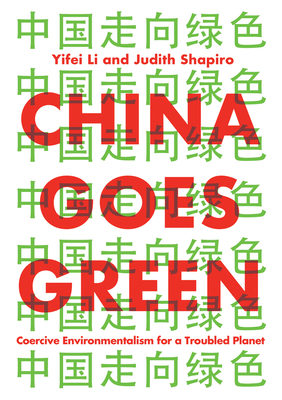In a short span of ten years, the international discourse around China’s environmental record has shifted dramatically. From the environmental “bad boy” that “wrecked” the Copenhagen climate talks in 2009, the country’s image in the environmental field has undergone a makeover. Its upholding of the Paris Agreement after the US withdrawal is celebrated as an act of global leadership. And its domestic environmental efforts, including the successful control, in a matter of years, of devastating urban air pollution, have been hailed as examples of effective state intervention into environmental crises.

In China Goes Green: Coercive Environmentalism for a Troubled Planet (Polity, 2020), NYU Shanghai Assistant Professor Yifei Li and American University Professor Judith Shapiro deconstruct the popular narrative. After a close examination of cases such as the anti-pollution campaign to shift heating from using coal to natural gas, Shanghai’s municipal waste mandate and infrastructure building under the Belt and Road Initiative, the authors uncover the coercive features of China’s brand of environmentalism. These they suggest not only lead to problematic implementation but also a fundamental erosion of social fabrics that support long-term sustainability.
The authors talked to China Dialogue by video call recently about their new book and how the world should approach coercive environmentalism in an era of deepening environmental crises.
China Dialogue: You took a close look at Shanghai’s compulsory waste-sorting policy as an example of “coercive environmentalism” in action. What lesson did you draw from this case?
Yifei Li (L): Garbage sorting is a massive initiative that affects every resident of Shanghai. There are a couple of features about this policy that we described in the book. The first is that it is a very restrictive policy, in the sense that there are designated hours within the day that people can dispose of their garbage, and if you miss that narrow window, technically you will be illegally dumping trash. And there are inspectors who are authorised to reprimand or fine people if they do not sort the garbage correctly. This points to an overwhelming amount of control without the adequate amount of education and awareness-building that should have predated this policy. A second set of features has to do with inconsistency. We see certain neighbourhoods aggressively ramping up their control over when, how and where people can dispose of their garbage, while certain other neighbourhoods have a fair amount of inaction.
Before Shanghai, Chinese cities had been experimenting with voluntary garbage sorting for almost two decades without much success, prompting many to argue that some coercion is probably needed to get people moving in the right direction. Celebrated systems in Taipei and Tokyo also involve restrictive hours. So where shall we draw the line here? How much coercion is good coercion in environmental policy?
Judith Shapiro (S): As Garrett Hardin, the biologist who came up with the concept of “the tragedy of the commons”, said, what’s needed is “mutually agreed coercion”. Coercion will work if it has the consent of the governed. And in the case of Shanghai it seems a decision was made that was convenient for the state but it doesn’t involve public buy-in or discussion. That’s what our book argues: sometimes governments have very good environmental intentions, but they fail in this area of public participation. It is precisely when there is no public participation that these “well-intentioned” environmental policies tend to fail in the long run.
How do you achieve “mutually agreed coercion” in practice?
S: Public comment and consultation are obligatory in many countries when it comes to legislation and policymaking, though many people don’t fully take advantage of that tool. In China, because of the constraints on NGOs and civil society groups, the state ends up taking more and more of the space that enables feedback and input from the society. Ironically, China is famous for the “mass line” (群众路线) in the Yan’an years [1935-45]. The Maoist roots involve a very high level of public participation. It seems that in the current era, the Party state has lost that tradition.
L: To achieve mutually agreed coercion we don’t need to look beyond China. If you look at the mechanisms of political consultation, they are written into the constitution. Consultation is an integral part of the Party’s political apparatus, not some foreign idea. One of the arguments that we tried to stress in the book is that we need to fully revive a system that China already has, to fully integrate and reprioritise that system in Chinese environmental policymaking.
In recent years, China has been “codifying” environmental policies into clear rules, regulations and laws. The Party’s guidelines for modernising environmental governance specifies in great detail the responsibilities of different stakeholders involved, including the government, corporations and individuals. Is that a way forward?
L: It has potential, but if all that’s involved is the state, then it is still inadequate. You could have a perfectly designed state political apparatus and you could give everybody a perfect division of labour so that they can work in concert with each other. But if that apparatus is in some profound way disconnected from the general public or if the public has no way of inputting into that “perfectly designed” system, then I just can’t see the point of that design. You can continue to improve the design, but it only makes sense insofar as it actually is closely tied to people’s livelihoods and their everyday lives.
S: The other thing is that all those codifications of responsibilities have a technocratic feeling. One of the problems we identify in the book is this tendency to be target-based, to put numbers on everything. Therefore, officials implementing such policies, who look upward to their superiors for their evaluations, are so focused on the numbers that the implementation often becomes heavy-handed and unfair.
When people think about coercive environmental policies, the opposite that often comes to mind is market-based solutions. China has also been experimenting with market mechanisms such as carbon trading. Where do you put them in your analysis of the “China model” of environmental governance?
L: Market-based mechanisms are not a core aspect of our analysis. Rather, the book highlights the various human consequences of pursuing environmental governance through authoritarian means, especially the disproportionate impact on minority groups and people who are already disadvantaged in Chinese society.
If you look at market-based examples such as ecological valuation and ecological compensation, they are, by definition, not sensitive to people who are already disadvantaged. They are designed to pursue maximum overall utility, oftentimes at the cost of the vulnerable. In that sense, by shifting attention to market-based mechanisms we are actually risking further deteriorating the livelihood of these people who are already disadvantaged.
I do not think there is enough robust evidence of environmental gains from such market-based “solutions”. Carbon trading has been extensively studied in multiple parts of the world but there is still very little evidence of it reducing emissions across the board. Rather, there seems to be a redistribution of carbon emissions quotas and a shift of burden from one firm to another or from one country to another.
If we use the Shanghai example again, would creating price mechanisms for recycling work better than the current coercive system and how would that affect vulnerable groups as you mentioned?
L: Many US states have bottle or can deposit policies that serve as an economic incentive to recycle. The policies require people to pay up front when they buy a certain item. And for people who are already struggling, you are basically asking them to cough up even more money. These are what economists call “regressive” taxes, because you are basically imposing the same percentage requirement on every citizen in the society. By definition, that fixed percentage is most significant for people with the lowest income.
What I would like to add is that before mandatory garbage sorting came out in Shanghai last year, it wasn’t as if there wasn’t any recycling. There was an awful lot of recycling, except that little of it was done by the government. It was done by migrants who go around the city on flatbed tricycles and collect all the paper, cardboard, bottles and cans, making a living out of it. The government’s sudden takeover of this sector essentially eliminated the jobs and the sole source of income for those who do have the best economic incentive to recycle.
Scientists such as James Hansen once argued that climate change required an “all-of-the-above approach”. As climate change impact becomes more severe day by day, we are hearing more arguments about not constraining our own options in fighting the crisis. How do you respond to that?
S: The climate crisis and other environmental crises are extremely urgent and indeed we need all the help we can get. We just have to tread carefully and look at what lies behind some of these moves. Our book urges all of us to go forward with our eyes wide open. We certainly applaud any contribution that China is making to resolve our global crisis. But we also need to ensure the participation of the people, maximum transparency in decision making, and well-crafted policies that consider local conditions, and ensure that other agendas are not underlying these seemingly well-intentioned environmental moves.
L: I absolutely agree that we need all the help we can get and this is really the all-hands-on-deck moment to planetary sustainability. And that is precisely the argument for not relying exclusively on the state. That is the argument for opening up to all of the civil society groups. The NGOs, the professional associations, the scientists, the lawyers. Their voices should be actively encouraged just so we can finally get all hands on deck instead of relying only on the most powerful one.








